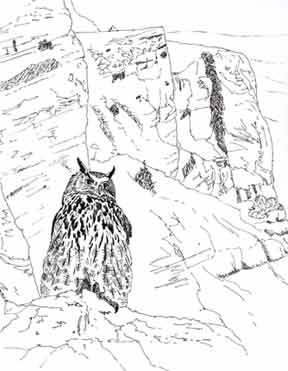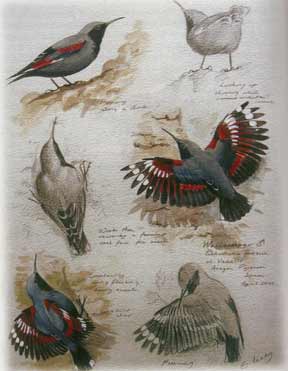April is the time when the Spanish steppes are at their yearly zenith and Little Bustards celebrate the fact with much foot pattering, leaping, wing flapping and head jerking! It’s time to impress the lady bustards and fend off male competitors and, in the opinion of the Little Bustard, there’s nothing like a bit of head jerking and raspberry blowing to do just the job.
Birdinginspain.com is teaming up with Jordi Bas, a renowned bird photographer who lives near Lleida, and Castellsdelleida.com (a local tourism agent) to offer a special trip for nature photographers who are keen to snap up the Little Bustard in one of its comic, er, dynamic postures.
And then there’s the Lammergeier sortie: we’ll take the lucky few along a long and winding path to a remote hide, we’ll drop bait for the Lammergeier and then we’ll leave the photographers alone with the birds until the following day! Lammergeiers are shy and wary but do not shun free food. So we’ll be hoping for good photographic opportunities for the Lammergeier as well as the Griffon Vulture and perhaps the Egyptian Vulture.
For the rest of the week we’ll concentrate our efforts on Bee-eaters, Penduline Tits, Blue Rock Thrushes, Little Owls, Calandra Larks… and more.
Hope you can make it! For more information go to the Birdinginspain.com website and send an e-mail to Steve West.
Posted in Birding and wildlife trips | No Comments »
Birding in Catalonia – The Eagle Owl
Birding is a pastime where no two days are ever the same. Regardless of whether you want them to be or not.
I was reminded of this recently. Returning home after escorting our youngest son to school I had hardly re-entered the flat when my wife urged me to grab my binoculars and telescope and to undertake the 15-minute drive to the village of Castelldans.
A group of 4 Swiss birders were eagerly awaiting my arrival. They were keen to see some of the key birds of the drylands of Alfés, above all the elegant Pin-tailed Sandgrouse.
Before long we were all standing on the edge of an area that I knew was good for the Sandgrouse. Our first find, however, was an enchanting flock of some 20 Red-billed Choughs, strolling around and pecking at the ground in their usual lively manner. Over a nearby rocky ridge a Kestrel was kicking up a ruckus, plunging, circling and calling hysterically. I raised my binoculars to see what all the fuss was about. My eyes goggled.

“Good God! An Eagle Owl!” I exclaimed.
My Swiss companions’ optics all immediately homed in on the magnificent bird sitting on an exposed rocky perch. So did the flock of Choughs, which before long had joined forces with the Kestrel in haranguing the unwelcome visitor. The Eagle Owl held its ground, and merely turned its head to blink at its antagonists. However, when this rather hesitant troupe was reinforced by a mixed band of cackling Magpies and determined Jackdaws the owl must have realized that peace and quiet would have to be found elsewhere, and took to flight.
There was a spring in my step for the rest of the day. For undoubtedly there had been a kind of wild, unrepeatable magic in those 5 minutes. It makes me wonder what I’ll see the next time I come here looking for Sandgrouse.
For indications about where to see Eagle Owls (and more than 100 other species) see Steve West’s first book “Where the birds are in northeast Spain”.
The Eagle Owl also lends its name to one of the chapters in Steve West’s highly-praised second book “Flying over the Pyrenees, standing on the plains”.
For further information see: http://www.birdinginspain.com
Posted in Birding and wildlife trips | No Comments »
Now I don’t know if it’s the first time on record, but it’s certainly the first time that I have ever seen both Pin-tailed Sandgrouse and Black-bellied Sandgrouse in the same day in the drylands of Alfés.
It’s not unusual to see Pin-tailed Sandgrouse here, in fact this is the only place in Catalunya where the species breeds (some 50 pairs at most?), but seeing a Black-bellied Sandgrouse is quite another matter. For one thing there are probably no more than 10 or 15 pairs of this avian gem left breeding in Catalonia, and they don’t breed at Alfés. Secondly, actually seeing them even if they are in the area requires luck, timing and a little celestial indulgence.
Alfés is only 6 or 7 minutes from my front door so I made a short incursion, mostly to locate the Pin-tailed Sandgrouse’s favoured haunts this season in preparation for a birding trip in late March. Two British birders have booked 2 nights in la Garbinada, a splendid rural hotel in the nearby village of la Granyena, and one of the prize birds around is precisely the Pin-tailed Sandgrouse. I don’t suppose the Black-bellied Sandgrouse will stay around until then, as when I last saw it it was flying directly away from me at a nifty speed!
Posted in Birding and wildlife trips | 2 Comments »
It’s December. Imagine you’re walking along the base of a steep rock face
somewhere in the Pre-Pyrenees. You detect a movement and look up. There’s a bird, and it’s close enough for you to see its long, slender downcurved bill and its slate-grey and black plumage. A moment later the bird flutters, and on its open, butterfly-like wings you see a dazzling flash of deep crimson.
Rejoice! You are now among the lucky few that have set eyes on one of nature’s jewels: the Wallcreeper. An amazing bird that is at home clinging to vertical rock faces in order to probe into nooks and crannies and pry out spiders and insects with that slender, downcurved bill. Little wonder then that when foreign birders visit this country this is usually the bird they most want to see, or that even the practical-minded Chinese have baptised it with the graceful name of “rock flower”.

In the breeding season the Wallcreeper inhabits sheer cliff faces in the Pyrenees at altitudes of between 2,000 and 3,000m. That means that between May and September the Wallcreeper is rarely an easy bird to see – first of all one has to reach its secluded mountain haunts and then one has to strain the neck muscles, and often the patience too, in order to spot it among towering mountains of naked rock.
That’s one reason though why winter is not all bad: by then Wallcreepers have left their high mountains in Spain to occupy more accessible terrain in the pre-Pyrenees, Montsant, els Ports…even cliffs by the sea at Cap de Creus.
One day last winter I made a personal pilgrimage to the sunny rock faces of Montsec and I received my reward. I took home the Wallcreeper’s colours and a little of its wing-flashing warmth, clutching onto the vision as I descended once more into the blanket of fog enshrouding Lleida and the surrounding plains.
And I hadn’t even strained my neck muscles.
Article published in Catalonia Today December 2007
Read more at http://www.birdinginspain.com
And Steve West’s latest book “Flying over the Pyrenees, standing on the plains”
Posted in Birding and wildlife trips | No Comments »
For the third year running Naturetrek are offering their excellent and well-researched trip to the Catalan Pyrenees. How could it be otherwise, seeing that they are relying on the intimate knowledge and expertise of BirdinginSpain.com to show their clients the very best of the region?
Highlights of the May 2007 tour are rather too numerous to describe here, but can be seen in detail in the trip report which is accessible at the following link:
Catalonia
We aim to repeat everything that made it a winning formula: the hotels, the sites and itineraries, and some wonderful encounters with an incredibly varied birdlife. Hopefully good weather will also be the name of the day!

For more details and the trip report click on the link above.
Posted in Birding and wildlife trips | No Comments »



